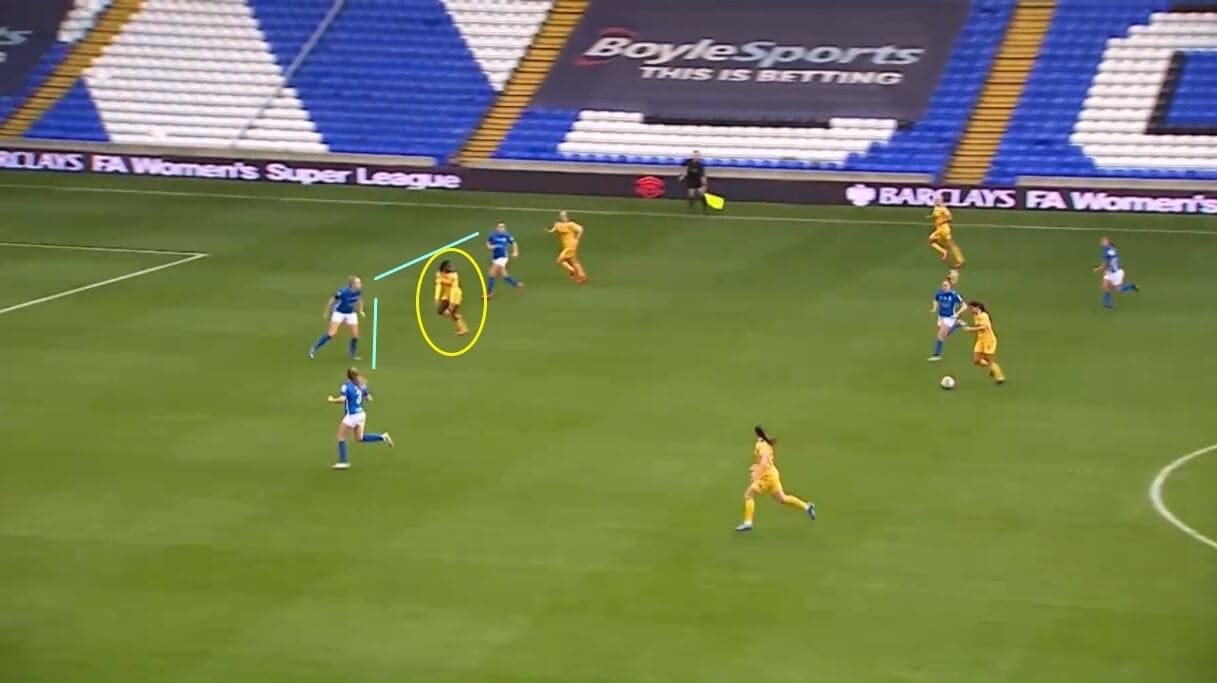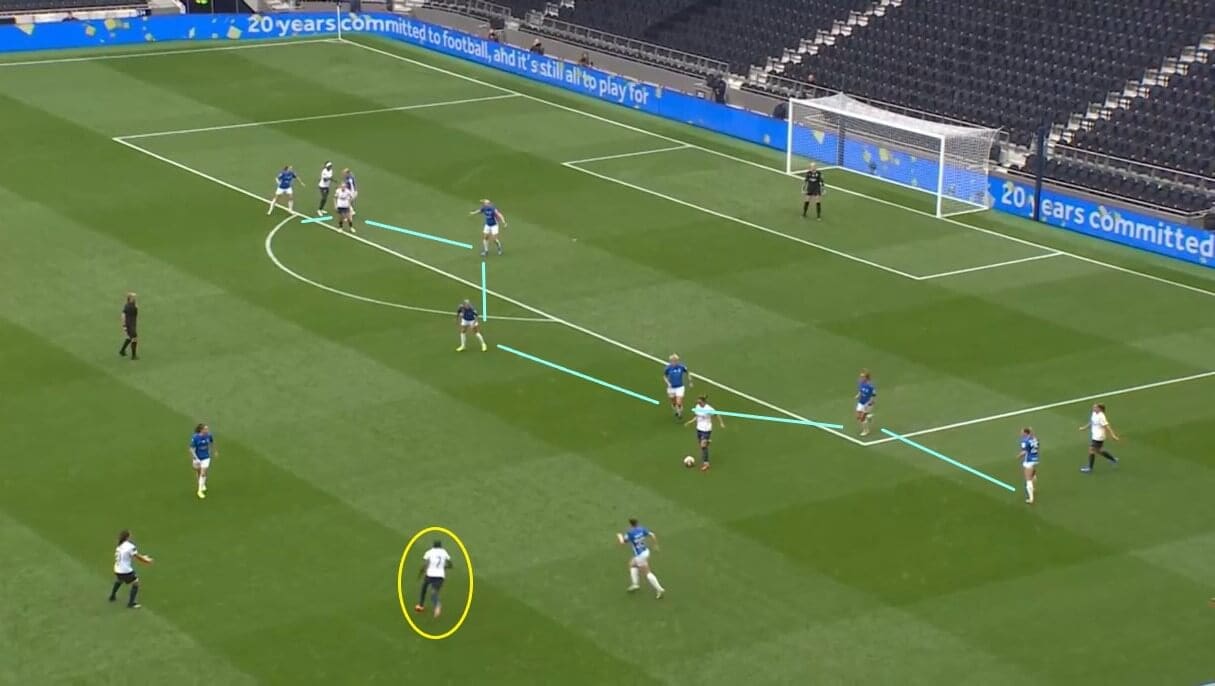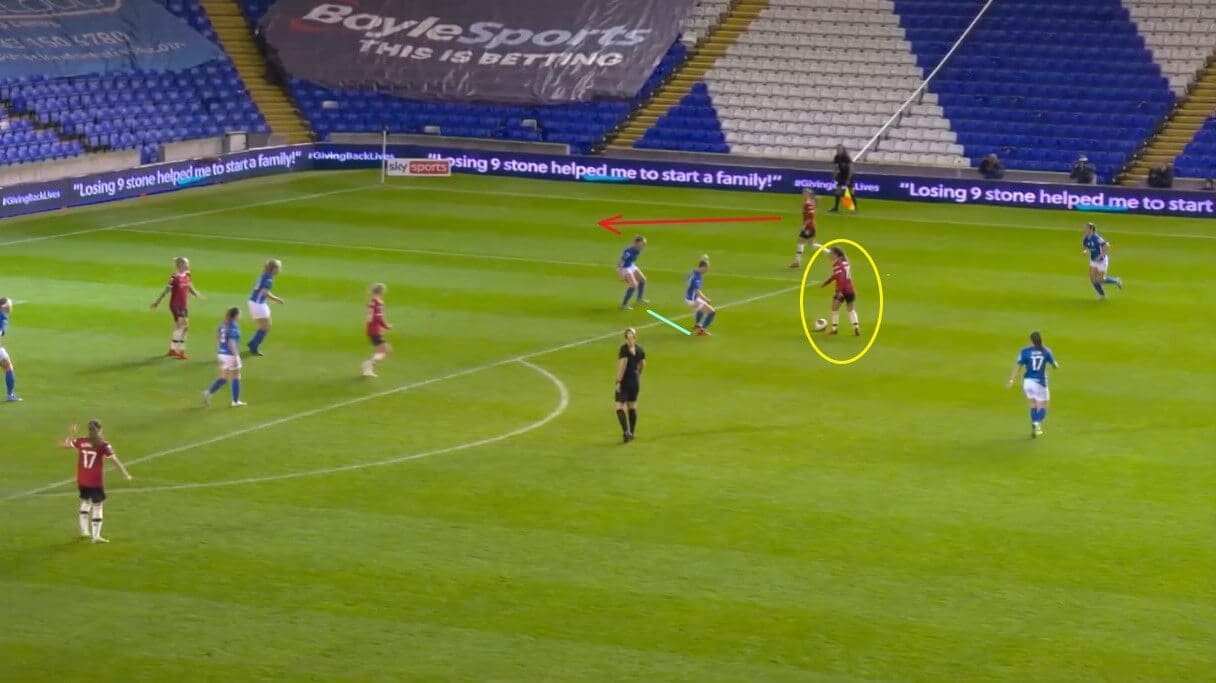It is fair to say that 2021/2022 was always going to be a tough campaign for Birmingham City Women, with a managerial change over the summer and the departures of the majority of last year’s squad hampering their pre-season preparations. As a result, when Scott Booth succeeded Carla Ward, having led Glasgow City to the last six consecutive SWPL titles, he was always going to need time to rebuild the team. However, despite 13 new arrivals, they have yet to win a game this season.
This tactical analysis will explore Birmingham’s performances in the WSL so far, examining their tactics and picking out the reasons for their struggles. In order to do this in a thorough manner, the scout report will look at their attack, midfield and defence in turn.
Attack
We will first focus on Birmingham City Women’s attacking play. Last season, under now-Aston Villa Women boss Carla Ward, they looked to get the ball up to striker Claudia Walker as quickly as possible, allowing her to get shots away with as few defenders as possible for company.

However, Scott Booth has preferred to push as many players up the field as possible to support the forwards, enabling them to pass the ball around opposing defenders and create plenty of goalscoring opportunities. The issue is that this only works if the players spread out and make the pitch as big as possible, as this forces the defenders to leave gaps open in their efforts to mark the attackers. By narrowing up, like in this image, Birmingham have not been able to turn these chances into goals, with only 0.25 goals netted per game, compared to 0.81 last season. On this occasion, Reading Women have closed down the three Birmingham players in the final third, highlighting how getting too close to each other makes it easier for the defenders to surround them.
However, the other problem that arises from this is that, when the ball reaches former Leicester City Women striker Libby Smith here, she has no options available in the middle to play the ball to. Therefore, she needs a player to run into the space behind the defence and give her a passing option, and improving this will allow Birmingham to create more chances and potentially score more goals.

The other thing that Birmingham need to work on is their decision-making. Here, Greece striker Veatriki Sarri, in the blue circle, has the ball, with teammates again in front of her. What Sarri needs to do here is to pass into one of those players and allow her team to work around Brighton and Hove Albion Women, but she instead holds onto the ball and tries to take it into the box herself. Brighton as a result close in on her instead, meaning that, when she releases the ball, there are no options open for her to find.
Sarri has been one of Birmingham’s more threatening players so far, making plenty of good runs in the final third, but this was one occasion when she made the wrong decision and prevented Birmingham converting a promising situation into a goal. Therefore, this is something else that they need to work on to improve their final third productivity.

Whilst Birmingham’s attacking issues are mostly technical, they do sometimes come down to simple hesitancy when they do find themselves in space. Here, against West Ham United Women, Republic of Ireland midfielder Jamie Finn, one of two summer arrivals from Dublin-based Shelbourne, has time to either cross into the box or shoot at goal, but ends up overthinking her options. As a result, she makes a weak cross which is cleared easily by the defenders.
When they find these spaces, Birmingham need to have more confidence in themselves, because this image shows that they do get into dangerous areas around the field, proving that they have a good awareness during games. However, their two goals scored is the worst return in the league so far (bottom side Leicester have scored three times) so what Scott Booth needs to improve is turning these opportunities into goals, through better positioning and accuracy with the ball.
Midfield
Birmingham City Women’s midfield tactics haven’t changed a lot since last season, with both Carla Ward and Scott Booth preferring their teams to keep the ball on the ground and play through the thirds.

Booth’s summer recruitment was completed with this in mind, as he brought in Scotland international Lisa Robertson on loan from Celtic Women to operate as a box-to-box midfielder in the Birmingham ranks. Robertson has been a key player in the middle third at St. Andrews so far, with her movement and ability to drop short when needed ensuring that Birmingham’s strength has come in the shape of their passing.
Here, Robertson has picked the ball up and run forwards with it, before playing it through the gap ahead of her and releasing her teammate to move into the box with it. As we know, this is where Birmingham then struggle, but it is clear that they need Robertson to continue doing well in this role if they are to win a game this season.

Robertson is not the only summer arrival to have been given an important role in the team. Scott Booth’s first signing at the club was Jade Pennock, who joined after leaving Championship side Sheffield United Women. Capable of operating as a winger, attacking midfielder or striker, Scott Booth has given her a freer role in the middle of the field, asking her to cause problems for opponents and act as a playmaker when the team is in attack. In this sense, she has taken over from Mollie Green, who played in the attacking midfield role last season under Carla Ward.
Here, Pennock has got herself into a hole between four Everton Women players, and her main strength so far has been good ball control, and she stops it well here, before taking it around the defenders and finding the back of the net. This shows the potency and threat that she has given Birmingham this season from the midfield, and she is another, like Robertson, who Birmingham will need to keep playing well, because she has undoubtedly been the main source of creativity in their midfield, and having her on the pitch will help them to keep having chances to score goals.

Birmingham have used a 4-4-1-1 formation 33% of the time this season, and a 4-2-3-1 19% of the time, compared to a 4-1-4-1 in 42% of their games last season. This indicates that there has been a greater focus on getting players back to protect the defensive line, with this image showing how the midfielders have linked up with the defenders to create a triangle, enabling Birmingham to play around the opposing attackers.
With this in place, Birmingham effectively have two units back when out of possession, increasing their chances of keeping the opposing team away from their goal area. Tottenham Hotspur Women here have plenty of numbers around the ball, but Birmingham have simply passed around them and ended the threat. However, this would not have been possible without the midfielders there, as Tottenham would have simply pressed the defenders and looked to force an error.
The midfield as a whole does not need major work, as it has mostly been a reliable area for them this season, although their passing accuracy of 68.2% is slightly down from last season’s 70.4%. However, with Birmingham still lacking a win and having only picked up one point from a possible 18, ensuring that this remains the case will give them the best possible chance of creating more opportunities and being harder to beat.
Defence
The final thing this analysis will look at is Birmingham City Women’s defence. This is where they are having a lot of problems, with 15 goals conceded in their six league games the second-worst defensive record in the division (ahead of only bottom side Leicester, who have conceded 17). They have also let in an average of 2.5 goals per game so far, compared to 1.96 last season, which highlights that this is where they need to focus the majority of their efforts on the training ground.

They have generally played with a high back line this season, which was the main reason that Reading Women defeated them so comfortably in their last game. One of Reading’s summer signings was Canada’s gold-medal winning midfielder Deanne Rose, who likes to play in a creative attacking role. Birmingham came up the field a lot of the time, leaving spaces open behind them for her to run into, with this image showing the Canadian between two defenders. As a result, Brooke Chaplen now has an option ahead of her to pass the ball to, allowing Reading to set up a goalscoring opportunity.
We have already seen how Birmingham are capable of sitting back and forcing teams to pass the ball around in front of them, with this being one of the reasons for Manchester United Women having to work hard to break them down in their meeting earlier in the campaign. However, when Birmingham do advance forward, they don’t then get back quickly enough, and that is one of the things that they need to address.

Their overall defensive structure, especially when playing with added numbers at the back, can also lack organisation and teamwork. Here, they have become jagged in their setup, with some players moving forwards and some holding their positions. This has created sizeable gaps between each of the players, which Tottenham are now looking to expose. Young winger Jessica Naz has been one of Tottenham’s most dangerous players this season, and good combination play with a teammate allows her to breach the defensive line and move into the box here, getting a shot away at goal. Therefore, better communication at the back to prevent these gaps appearing is also needed, as a flatter line here might have made it harder for Tottenham to break them down.

We mentioned that Manchester United had to work hard to break Birmingham down when they met at the start of October, but the two goals that Marc Skinner’s side did score were the result of mistakes made by Birmingham’s defenders. The first saw full-back Hannah Blundell, who has impressed this season, running around the defence and setting up winger Leah Galton in space, and the second came from this situation. Captain Katie Zelem has possession here, with two Birmingham players ahead of her. However, neither came out to close her down, and also didn’t drop off to fill the space behind them. Instead, they held their positions, which allowed Zelem to feed the ball through to Blundell, who was making the run through to meet it, and she in turn set up England star Ella Toone to score the goal.
What would have made it harder for Manchester United to score here was if one of the defenders had closed Zelem down, forcing her into passing the ball earlier than she would have preferred to, and this would have also meant that Blundell would not have been in the right position to cross the ball into the box. Equally, if the other defender had simultaneously dropped back into the open space, they could have blocked any attempted cross made by Blundell. Therefore, by simply adjusting their positioning here, they could have prevented the ball going into the box, which would have kept them in the game.
Conclusion
In conclusion, Birmingham City Women’s problems have mainly been down to their own errors at both ends of the pitch, and all of them can be fixed. We have also looked in this tactical analysis at how their midfield has been built to support their defensive and attacking play, which has been a crucial element in their performances so far. Birmingham have gone through many changes this season, with virtually a brand new squad that needs gelling together, and there have been glimpses of promise from them. It is now just a ca of addressing the problems we have highlighted and finding their confidence, both of which will help them to get more goals and points on the board.





Comments